Social media marketing might be flashy and exciting, but there’s a reason why you hear marketers insisting businesses pay more attention to search engine optimization (SEO).Back in 2019, 68% of online experiences began with a search engine. In just five years, the rising popularity of apps like TikTok and Instagram, along with rapid integration of AI across platforms, have shifted this behavior. Now, online search is split up between search engines and social media sites—and we’re still waiting to see the impact of generative AI on search (think: OpenAI’s ChatGPT and Google’s latest launch, AI Overviews). In fact, 55% of businesses predict most people will prefer AI chatbots over search engines in 2024.
Most people already know we’re in the digital age and that, in order to thrive, businesses must establish a strong online presence. What they might not realize is that while social media platforms like Instagram and Facebook offer valuable opportunities to showcase products, engage with customers, and build brand awareness, they are not the only avenues for attracting potential clients.
The fact is, search remains just as valuable as social media. Realistically, how do people who don’t know about your brand find you? How do customers investigate what others think of your products or services? And how do they compare your company to a competitor?
They search.
This doesn’t mean you should abandon your company’s social media accounts. As our CEO Shama Hyder shared in a recent interview, if you’re a coffee shop selling a new, seasonal hot chocolate, you don’t necessarily need to drive customers to your website in order to sell that drink. In that case, maybe updates on social platforms are enough. However, we’re not all coffee shops selling a seasonal beverage, and if that coffee shop had even a slightly different goal in mind—like showing up when a potential customer who has never heard of them before types “coffee shop near me” into their phone—they’d want their website to rank as high as possible in search results. So, it’s important to strike a balance between SEO and social media marketing to maximize your reach and engagement.
With expert SEO strategies, you can enhance your brand’s virtual visibility. Let’s investigate the importance of search, the challenges businesses face when it comes to SEO strategy, and explore the best solutions.
The Power of Search
Organic traffic, also known as SEO traffic, refers to when users travel to a website through unpaid search results. And, when people are looking for products or services, they often turn to search engines like Google. In fact, Google is the most used search engine in the world, with a mobile market share of 95.32% and a desktop market share of 81.95%. Even if they don’t know about your brand specifically, people will use relevant keywords to find businesses that meet their needs. It’s crucial that your business ranks among them. There’s a reason why you hear marketers insisting businesses pay attention to SEO. According to a study by Ahrefs, 96.55% of all pages get zero search traffic from Google.
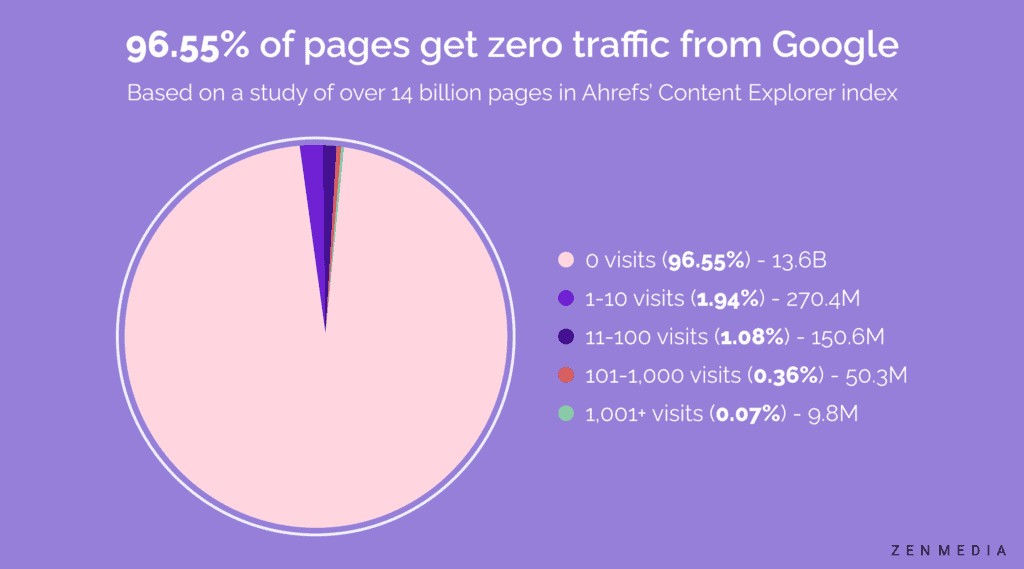
And partially because the average time a person can focus has dropped from 2.5 minutes to 45 seconds, Google has adjusted the way it ranks and displays search results.
In an analysis of a million search engine results pages (SERPs), AuthorityHacker determined the top position in Google’s search results is usually the most relevant result. For branded keyword searches, Google will prioritize the obvious result, even if it goes against other ranking factors and SEO rules.
However, for less obvious, non-branded keyword searches, featured snippets dominate, taking up 50-65% of all number one spots. This trend indicates that Google is providing more immediate answers and reducing the number of clicks on SERPs. This is crucial for businesses to understand because it means that much of the actual SEO competition for organic traffic now happens at the second and third positions in search results.
The Rise of REO
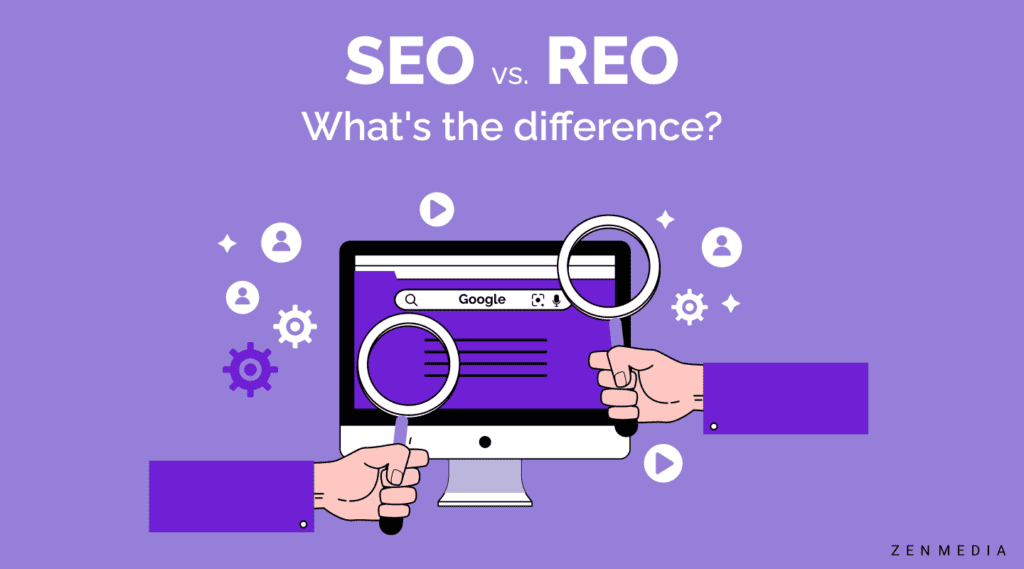
You can’t go anywhere online today without seeing something about AI. That’s why we would be remiss if we didn’t mention the rise of REO, or recommended engine optimization.
So, what is REO?
REO refers to AI-powered experiences, such as ChatGPT, Perplexity, and Google Gemini. These machine learning and language learning models (LLMs) offer suggestions and citations referencing sites they discover when searching the web for solutions to user queries. That means we can’t just make adjustments to account for how our website content is seen by search engines—we have to make adjustments to account for how our website content is considered by AIs.
Google recently launched AI-generated overviews for search results and is beginning to offer multi-step reasoning for complex questions. AI-powered search features are designed to provide more personalized and contextual search experiences by better understanding a user’s search intent, which is meant to lead to higher user engagement and satisfaction.
So, as AI continues to shape the future of search, it’s becoming increasingly crucial for businesses to understand and adapt to the unique requirements of REO alongside SEO strategies. By optimizing content for both search engines and AI-powered recommendation systems, companies can ensure that their websites remain visible and relevant to users across a wide range of search and discovery platforms.
Common SEO Mistakes
Many businesses make the mistake of focusing too heavily on technical details while neglecting the basics.
Optimize User Experience
You could have the most accurate long-tail keywords in the world (and that is important!), but a website that loads slowly, looks bad on mobile devices, or makes it difficult for customers to find the information they need will struggle to rank well in search results.
Think Like a User
Another common pitfall is failing to think like a user. If you don’t understand what your target audience is searching for, you won’t be able to optimize your site effectively. If you’re selling a coffee delivery subscription service, that needs to be the focus of your home page—not your line of eco-friendly reusable coffee mugs.
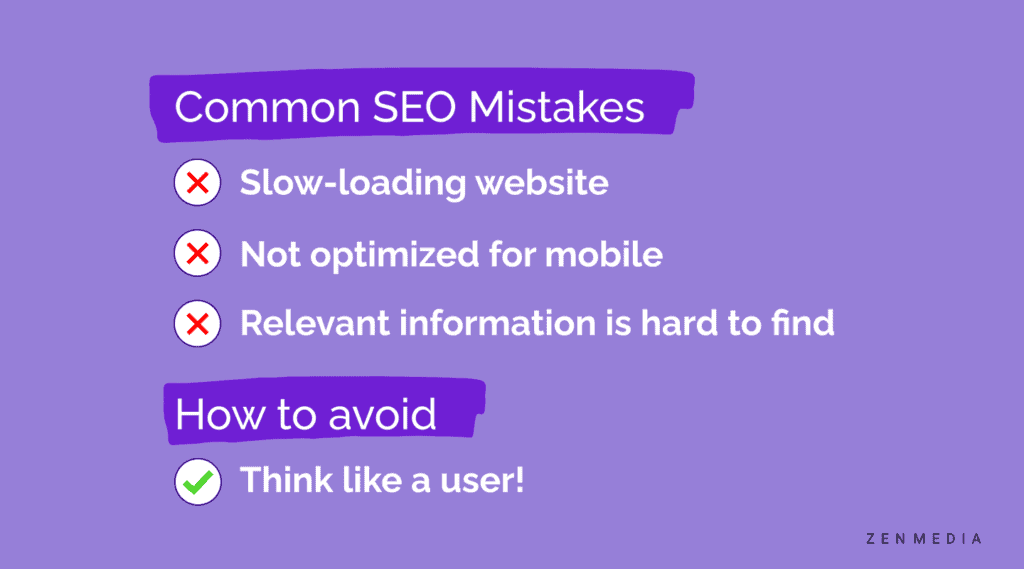
Claim Your Business Profile and NAP
Don’t forget to claim your business profile on platforms like Google My Business and Yelp. By verifying your business information, you can ensure that search engines display accurate details about your brand. Encouraging satisfied customers to leave reviews on these platforms and featuring testimonials or case studies on your website can also boost your credibility and search rankings.
Along those same lines, don’t forget to ensure your name, address, and phone number (NAP) are clearly visible. This is a particularly important local SEO strategy for businesses with physical storefronts, but it’s still important to include this information if your company is digital.
How to Improve Your SEO
To improve your SEO strategy, start with the fundamentals.
Mobile-friendly Matters
Ensure your website is clean, fast-loading, and mobile-friendly. Prominently display essential information such as your menu, hours of operation, price range, and contact details.
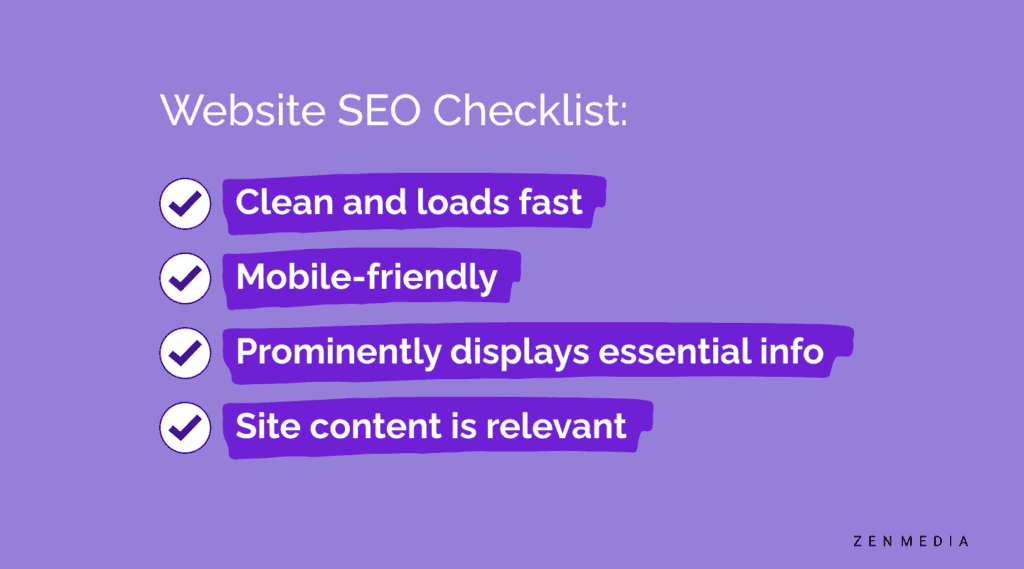
Market Research and CX
Be sure to conduct market research to gain insights into your customers’ search habits, search volume, search intent, and preferences, and use that information to develop a user-centric approach that prioritizes the customer experience (CX).
Strategic Organization

Last year, there was a 186% increase in ranking factor for companies that created a dedicated page for each of their offerings. So, to use the coffee example again, it’s okay to sell a coffee delivery subscription service and eco-friendly mugs—just don’t cram them all onto the same page.
Deliver Resources
Another important trend we’re seeing is that website visitors and search engines appreciate informative, helpful resources shared on company websites. These resources, like blogs and whitepapers, not only increase a visitor’s time spent on your company’s website, they also improve your SEO. When it comes to an SEO content marketing strategy, blogs are crucial. Blogs are the most prevalent form of content found in the top 10 SERP results (excluding home pages) and make a frequent appearance within the top 3 to 5 results.
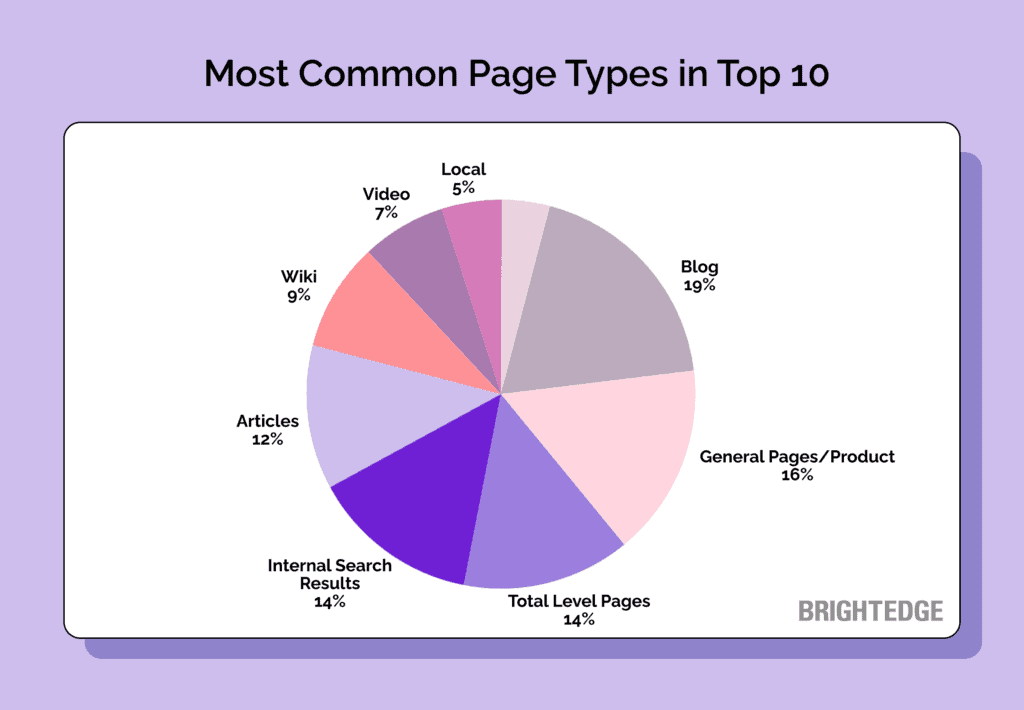
This means blogs play a significant role in contributing to your company’s SEO and page rankings.
Recommendations for Writing Successful Blogs that Drive SEO
An SEO content marketing strategy—particularly a B2B content marketing strategy—should always include blogs. Blogs have the ability to resonate with your audience and establish your brand as a credible, reliable source customers can trust. So, it should come as no surprise that B2B marketers who have blogs get 67% more leads than those who don’t. Blogs consistently rank high in searches, but only if they’re designed with the following in mind:
- Prioritize Your Audience: Ensure your content strategy accurately reflects what your audience is looking for.
- Maintain Consistent, High-Quality Content: Regularly post relevant, engaging, grammatically correct blogs to ensure strong content quality.
- Leverage Data: Share interesting data from reliable sources to support your content.
- Feature Different Content Types: Share different kinds of content that explores intriguing, opinions, data, and breakthroughs that are relevant to your brand
- Regularly Update: Conduct regular blog audits to refresh and update content in order to retain relevance and maintain (or even improve) ranking.
Well-executed blogs can become powerful tools for driving SEO and attracting valuable leads to your website. By prioritizing your audience’s needs, maintaining a consistent stream of high-quality content, leveraging data to support your arguments, and regularly updating your blog posts, you can establish your brand as an authoritative and trustworthy source in your industry.
Remember, the key to success lies in understanding your target audience and delivering the information they seek in an engaging and accessible way. With a dedicated focus on these recommendations, your blog can become a significant asset in your overall SEO content marketing strategy.
The Importance of Long-Tail Keywords for SEO Keyword Strategy
These days, search engines operate more like neural networks than they do databases. This is because we less often search for things with single words and are more likely to type full questions. A search query like “coffee shop near me” is one example, but it gets more granular. You can see for yourself by typing, “How to…” or “Why is…” into Google’s search bar. The suggested search terms are almost always full-length (sometimes hilarious) questions.
Enter: long-tail keywords. Long-tail keywords are specific phrases consisting of three or more words. There are several benefits to leveraging long-tail keywords, such as how detailed and niche they can get. Due to their more precise nature, it’s often easier to rank higher with long-tail keywords than it is with traditional, single-word keywords.
Here’s an example so you can see the difference:
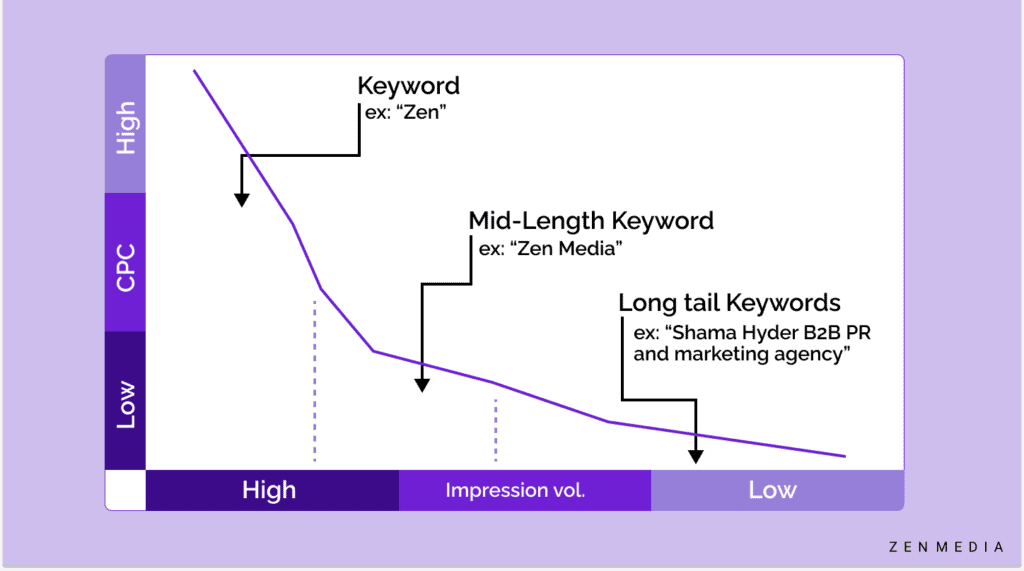
- Keyword: Zen
- Mid-Length Keyword: Zen Media
- Long-Tail Keyword: Shama Hyder B2B PR and marketing agency
It’s critical to have a strong SEO keyword strategy, so conduct research and use at least one keyword research tool to discover what long-tail keywords are most relevant to your company and your customers—this includes questions! Once you’ve got a list of keywords (and keyword rankings, because not all keywords carry equal weight), be sure to weave those target keywords throughout your website and blog posts in order to positively influence your SEO.
Why Your SEO Strategy Should Include Internal and Inbound Links
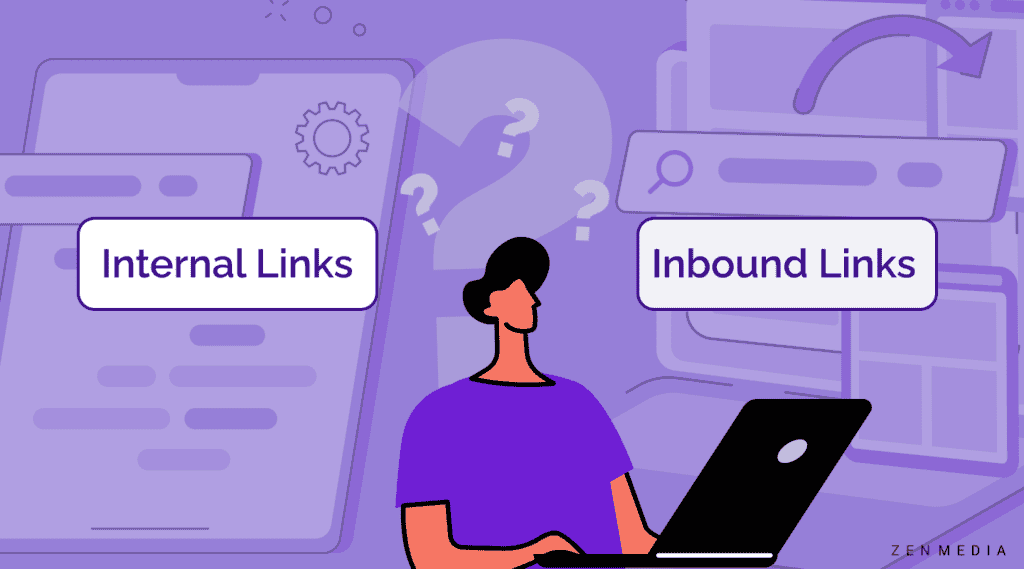
Internal links are not the same as inbound links, though both are important for a comprehensive SEO strategy. Inbound links, also known as backlinks, are links from other websites that send users to your site. Inbound links are crucial because they improve your authority and credibility in the eyes of users and search engines. However, only relevant sites that link to your site have much of an impact on your SEO and authority.
You might be wondering, How do I obtain high-quality backlinks? Well, there are several strategies for securing backlinks, including participating in guest blogging on other sites, earning mentions in publications, and generally creating top-notch content that other content creators genuinely want to reference.
The Importance of Internal Links
Internal links are hyperlinks that point from one page on your website to another page within the same domain. By strategically linking your site’s pages together, you can boost your SEO efforts in several ways:
- Improved Site Navigation: Internal links help users navigate your website more easily, allowing them to find relevant content quickly and efficiently. This enhances the user experience and encourages visitors to spend more time exploring your site, which can lead to increased engagement and conversions.
- Increased Page Views: By linking to related content within your website, you encourage users to visit multiple pages during their session. This not only increases page views, but also helps search engines understand the depth and value of your site’s content.
- Better Site Architecture: A well-structured internal linking system helps search engines crawl and index your website more effectively. By creating a clear hierarchy and linking your most important pages together, you make it easier for search engines to understand the relevance and authority of each page on your site.
- Improved Link Equity Distribution: Internal links allow you to distribute link equity (we wish we were kidding, but this is also known as “link juice“) throughout your website. By linking from high-authority pages to other relevant pages on your site, you can boost the overall authority and ranking potential of those linked-to pages.
- Keyword Optimization: When creating internal links, you can use descriptive anchor text that includes relevant keywords. This helps search engines understand the context and topic of the linked-to page, which can improve its ranking for those specific keywords.
Maybe this doesn’t need to be said but there’s also another reason internal links are important: they keep users on your website longer, increasing exposure to your brand and enhancing brand awareness.
Relevant external links are important too, particularly when you’re citing sources, referencing news events, or discussing trends. That said, you do want to keep people on your website, and internal links positively impact SEO. So, to maximize the benefits of an internal linking SEO strategy, it’s essential to create a logical and intuitive linking structure that guides users and search engines through your site’s content.
Ensure you never have broken links, and focus on linking to relevant, high-quality pages and use descriptive, keyword-rich anchor text when appropriate. By incorporating a strong internal linking strategy into your overall SEO efforts, you can improve your site’s visibility, user engagement, and search engine rankings.
Encourage and Share Customer Reviews

Today, most customers read online reviews before purchasing from a local business. In fact, 36% check two review sites, and 41% check three sources or more. And, when it comes to SEO and your SEO strategy, Google and other search engines take reviews into account. They’re considered “trust signals.”
Prioritize UGC
Google particularly places substantial trust in user-generated content (UGC), which includes customer reviews. If you’re a local business wanting to show up in Google’s Local 3 Pack for any given search (this means the first 3 businesses it lists alongside an image of a map), positive reviews can help get you there. A recent study showed that review signals—such as first and third-party reviews, review velocity, and review quantity—currently account for 16% of Local 3 Pack ranking factors.
Respond to and Redistribute Reviews
But this isn’t just relevant for local businesses—all businesses benefit from encouraging and sharing positive reviews. Google’s Quality Rater guidelines put a great deal of emphasis on online reviews, and responding to these reviews can boost your SEO as well. So, be sure to respond to reviews quickly and professionally to attract potential customers. And remember, you can leverage positive reviews for engaging social media posts, website content, facilitating brand trust, social proof, and more.
The Ultimate Goal: Conversions
Driving traffic to your website is only half the battle; your ultimate goal is to convert visitors into customers. By investing in SEO, you can build the credibility, awareness, and trust necessary to encourage conversions and ultimately boost conversion rates. Of course, investing in a robust social media presence helps with all three of those elements as well, which is why we recommend a cohesive, comprehensive approach that leverages both SEO and social media.
Still, ranking on top of the SERP in your niche or industry generates 39% click-through rate (CTR), while the second and third-ranking results clock in at 18% and 10%. In short? Don’t sleep on SEO.
Bring in the Experts
Navigating the complex world of SEO can be challenging, especially for businesses with limited time and resources. Yet, in a world where 70% of companies report that SEO generates more sales than pay-per-click (PPC) advertising, it’s important to consider the value and effectiveness of SEO in driving valuable traffic.
Partnering with digital marketing experts who specialize in SEO can help you identify relevant target keywords, optimize your content, and uncover additional opportunities for improvement. These professionals stay up-to-date with the latest trends, best practices, and SEO tools, ensuring that your website remains competitive in search results. Optimized website content guided by experts can lead to increased traffic, better engagement, and more conversions.Are you looking for digital marketing experts who know all about SEO? Look no further. Contact us today to set up a consultation.




